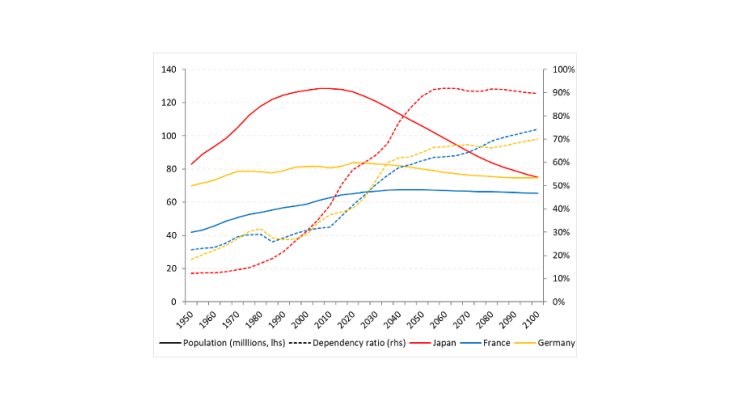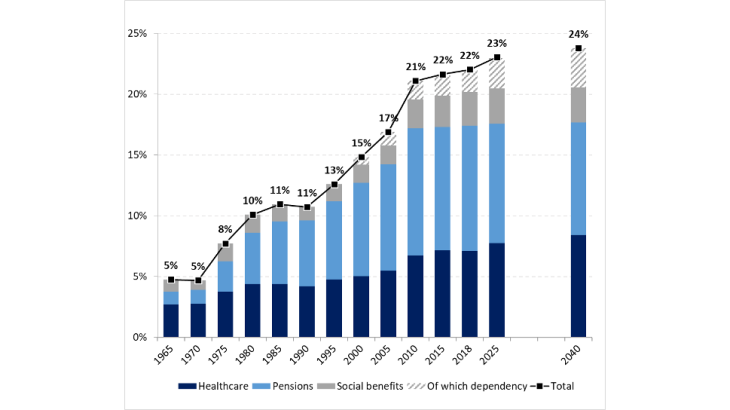Japan's population declined by nearly one million between 2010 and 2015 and is expected to fall by a further 53 million by 2100. In 2100, the dependency ratio (ratio of over-65s to 25-64s) is expected to rise to 90%, compared to 50% in 2015. The demographic challenge is not specific to Japan, but the situation there differs in terms of its place in the cycle and the magnitude of this trend (see Chart 1). A forerunner in the cycle of demographic decline, Japan provides useful experience in understanding policy responses to the challenges posed by population ageing.
Although Japan's fertility rate fell below the replacement rate in 1975, the government only took heed of the risk of demographic decline and its impact on the sustainability of the welfare system in the 1990s. Two options were then available: either attempt to offset this decline through a pro-natalist policy or immigration, or to manage it by adjusting welfare spending.
Doubts surrounding pro-natalist and immigration policies
The first option met with two difficulties: the lack of funding allocated to it and the uncertainty regarding the objectives.
- Family policy has focused on changes in legislation with questionable efficacy, while funding has remained low. For example, while a law was passed in 1992 to extend maternity leave from three months to one year, pregnant women continued to be urged to resign. And it was not until 1997 that sanctions for such a practice were imposed. Even today, it often remains a choice between having children or continuing one's career.
- As regards immigration policy, in 1990 a plan was introduced to attract the descendants of Japanese families who had emigrated to Latin America. But this plan was revoked in 2008 with incentives for them to return to their country of origin. Since 1993, a vocational training system has been used to recruit foreign workers on temporary contracts. The foreign population remains low (2% of the workforce) and naturalisations are almost non-existent.
Parametric adjustments to pension and health spending
These developments suggest that policymakers have accepted the demographic decline. Their efforts have aimed to balance welfare spending through parametric or automatic changes. A law passed in 1994 aimed to gradually raise the retirement age from 60 to 65 by 2030 and increased pension contributions; in 1997, a law streamlined medical care and doubled the co-payment in healthcare; in 2000, pension benefits were reduced and a benefit scheme for dependency was set up; in 2004, a pension reserve fund was created and an automatic mechanism for below-inflation rises in pensions was introduced and then extended in 2016 to take account of periods of negative inflation; lastly, in 2014 VAT was increased partly to finance the burden of population ageing.
Nevertheless, growth in welfare spending has been staggering (see Chart 2). It currently accounts for 22% of GDP compared with just 5% in 1970. The biggest increase has been in pension spending, which rose by 9.2 percentage points since 1970 in a country where the number of retirees has exploded (22 million in 2000, and 35 million in 2018) and where life expectancy at retirement age is the highest in the world (22 years). The 4.4 percentage point surge in health spending is also linked to ageing, which accounts for 70% of this increase since 2000 (OECD, 2017). Lastly, the deficit of the specific welfare assistance system for the elderly created in 2000 is increasing by the year.
This welfare spending is expected to continue to grow and reach 24% of GDP in 2040. While public pension spending is expected to remain contained, the escalation in healthcare and dependency spending is likely to continue since per capita drug consumption, in connection with ageing, is 46% higher than the OECD average. In 2015, an annual ceiling of JPY 500 billion (0.11% GDP) was set for the increase in age-related social spending. But in reality, it is far higher: Ministry of Labour forecasts show an annual growth of JPY 3 trillion between now and 2040, of which JPY 720 billion will be for dependency alone.

